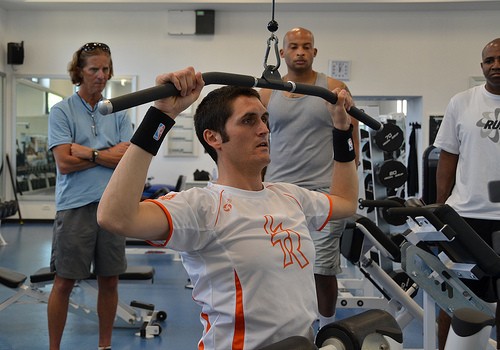
Behind-the-head Pull-downs
Behind-the-head pull-downs on lats machine or behind-the-head pull-ups can, like behind-the-head presses, increase your chances of overuse injury to your shoulder joint or the rotator cuff. Just a note here: the things that we spoke about in the last slide - about the shoulder joint - are relevant here as well. Behind-the-head pull-downs or pull-ups are done at shoulder joint angles which are at the extreme, to say the least. Thus, there is more likelihood of injuries to cartilage and other joint support tissues. The only difference, while behind-the-head shoulder presses can be done in some instances, there isn't much logic in doing behind-the-head pull-downs or pull-ups. TAKE HOME MESSAGE: If you've been doing behind-the-head pull-downs or pull-ups, stop now! There isn't much benefit (over the normal pull-downs or pull-ups). Only thing you are likely doing is increasing the stress on your shoulder joints!
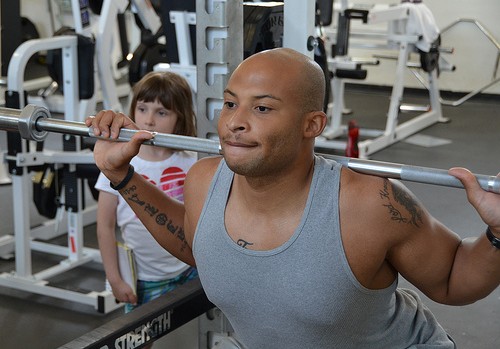
Behind-the-head Press
Sore or painful shoulder is one of the commonest complaints that you will come across in a gym! Over the years, if you've been a seasoned gym-goer, you must have heard people talk about behind-the-head press being bad for you. I have mixed feelings about this! First of, it is relatively bad for someone just starting out and someone who does 'high-volume' training (too many reps and too many sets. The reason - well, shoulder joint is a very tiny joint. And, also a very unstable one at that. No wonder, it needs the rotator cuff to hold the head of the humerus (the long bone of your arm) in place. A reason why that is the case is because the hand has to reach out in all different planes to grab things - be it food or whatever. So, nature has sacrificed stability for flexibility. Contrast that with the hip joint (a similar ball and socket joint). The head of the femur (long bone of the leg) is very deep inside the joint socket. Hence, the hip bone is stable but not that flexible. Result - the hip joint can take the weight of the body all day long...
Sore or painful shoulder is one of the commonest complaints that you will come across in a gym! Over the years, if you've been a seasoned gym-goer, you must have heard people talk about behind-the-head press being bad for you. I have mixed feelings about this! First of, it is relatively bad for someone just starting out and someone who does 'high-volume' training (too many reps and too many sets. The reason - well, shoulder joint is a very tiny joint. And, also a very unstable one at that. No wonder, it needs the rotator cuff to hold the head of the humerus (the long bone of your arm) in place. A reason why that is the case is because the hand has to reach out in all different planes to grab things - be it food or whatever. So, nature has sacrificed stability for flexibility. Contrast that with the hip joint (a similar ball and socket joint). The head of the femur (long bone of the leg) is very deep inside the joint socket. Hence, the hip bone is stable but not that flexible. Result - the hip joint can take the weight of the body all day long but you can't rotate your leg the way your arm goes, for instance when you go bowling! Another key issue with the shoulder joint is that it is involved in almost all exercises - even when you hold a barbell at rest, you stick your scapulae together and BOOM!, you shoulders kick in. When doing squats, when you push your elbows and stiffen you back, BOOM AGAIN, shoulders kick in. Deadlifts, pull-ups, bench press, you name it - all of them have a shoulder component. In fact, suggest a movement where you don't think shoulder is involved and I will buy you a tub of whey protein of your choice. Right, before you suggest leg press or leg extensions, go heavy enough on it, stick your chest out, go into an isometric concentration and you will notice that the shoulder do kick in. The same goes for almost all sporting movements as well. The frequency with which the shoulder is involved in your training can sometimes be good - if you know how to stabilize your shoulders - chances are, you will have strong, broad and supple shoulders. Sadly, joint positioning is not something that many people - let alone elite athletes - know about. And, therefore the problems with joints. The laxity issues (and in some cases stiffness) combined with the 'overkill or overuse' factor and makes the behind-the-head overhead press a 'strict-no-no' for most people. However, if you are an advanced or even intermediate level weightlifter (Olympics), some amount of behind the head jerks or 'Pop and Drops', also called the Quick Drops as an accessory to improve snatches, (1) wouldn't do any harm. This is so because by definition Olympic lifts are quicker movements - there won't be much grinding of the cartilages and joint surfaces of the shoulder as in slow-paced, 'bodybuilding-kind' of exercises. TAKE HOME MESSAGE: AVOID BEHIND THE HEAD OVERHEAD PRESSING movements of any kind. However, when you are in an advance stage and know how to stabilize your joints, you might as well put in a bit of behind the head work!
- Important notification about information and brand names used in this slideshow!
- Photo courtesy of USAG Livorno PAO by Flickr : www.flickr.com/photos/campdarby/5725389881
- (1) http://exrx.net/WeightExercises/OlympicLifts/QuickDrop.html
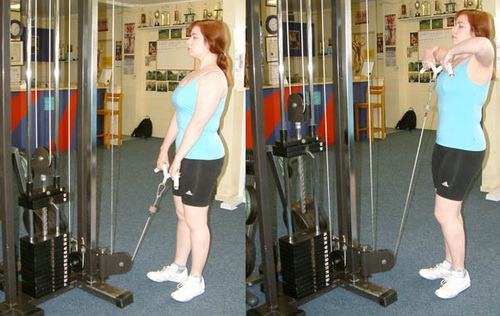
Upright Rows
There is a lot of talk amongst fitness aficionados regarding the risk of upright rows and their potential to cause rotator cuff problems. Some people even tend to put them on par with the high risk moves like behind-the-head press or behind-the-head pull downs. However, I wouldn't go to that extend. Upright rows are either good for you or bad for you - depending on how you do them or who you ask! More likely than not, those who advise against upright rows won't be having all that great a technique. First of, to increase the safety and efficiency of your upright rows, you need to be able to stabilize your shoulders. Shoulders elevated and pulled back, scapulae (shoulder blades) drawn together, a proud chest and a pulled-in core will give you that much needed stability. Having said that, however, if after working on your technique for a few weeks (or sessions), you don't feel it in the muscles or if it causes pain in the shoulder joint - it's time to chuck the exercise out of the window! An effective and safer alternative to upright row is the HIGH PULL (1,2). This wonderful movement is very effective in packing...
There is a lot of talk amongst fitness aficionados regarding the risk of upright rows and their potential to cause rotator cuff problems. Some people even tend to put them on par with the high risk moves like behind-the-head press or behind-the-head pull downs. However, I wouldn't go to that extend. Upright rows are either good for you or bad for you - depending on how you do them or who you ask! More likely than not, those who advise against upright rows won't be having all that great a technique. First of, to increase the safety and efficiency of your upright rows, you need to be able to stabilize your shoulders. Shoulders elevated and pulled back, scapulae (shoulder blades) drawn together, a proud chest and a pulled-in core will give you that much needed stability. Having said that, however, if after working on your technique for a few weeks (or sessions), you don't feel it in the muscles or if it causes pain in the shoulder joint - it's time to chuck the exercise out of the window! An effective and safer alternative to upright row is the HIGH PULL (1,2). This wonderful movement is very effective in packing on tons of muscle over your shoulders, traps, upper back and arms. What's more, it isn't as high a risk on the rotator cuff as the upright row. In fact, with the external rotation of the arm and the shoulder in the high pull, you stand to make your rotator cuff stronger! Furthermore, since by definition, high pulls are power movements, they are more likely to improve your sports performance. Another alternative to the upright row is the horizontal lats pulley. TAKE HOME MESSAGE: Learn to stabilize your shoulders when doing upright rows. An effective alternative is the high pull.
- Important notification about information and brand names used in this slideshow!
- Photo courtesy of GeorgeStepanek by Wikimedia Commons : en.wikipedia.org/wiki/File:CableMachineUprightRow.JPG
- 1. http://www.t-nation.com/free_online_article/most_recent/the_clean_high_pull
- 2. http://catalystathletics.com/exercises/exercise.php?exerciseID=99
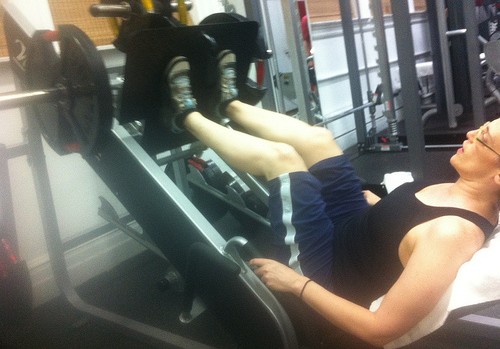
Leg Press with Cramped Knees
Leg press can be a very effective exercise - provided you learn to do it correctly and get the most out of it! Let us have a look at some mistakes that people often do when doing the leg press. Mistakes: 1. USING TOO MUCH WEIGHT TOO SOON: It is very easy to fall prey to the temptation of packing on plates - most guys will be able to do four/ five 45 pounders on each side within a few weeks of starting training. However, if you do that, chances are you are most likely to be stuck with that weight for the rest of your life. Solution: learn the correct technique of leg-press and get strong every step of the way before moving on to the next level of poundage. 2. CRAMPING UP YOUR KNEES: Many-a-times, you'd see people - when they leg-press - let their knees fall in on the way down. That is a very weak knee position and also not very efficient - meaning with that kind of knee position, you are more likely to get injured and you'd be hard pressed to work with too much weight. Solution: Flare you knees on the way down...
Leg press can be a very effective exercise - provided you learn to do it correctly and get the most out of it! Let us have a look at some mistakes that people often do when doing the leg press. Mistakes: 1. USING TOO MUCH WEIGHT TOO SOON: It is very easy to fall prey to the temptation of packing on plates - most guys will be able to do four/ five 45 pounders on each side within a few weeks of starting training. However, if you do that, chances are you are most likely to be stuck with that weight for the rest of your life. Solution: learn the correct technique of leg-press and get strong every step of the way before moving on to the next level of poundage. 2. CRAMPING UP YOUR KNEES: Many-a-times, you'd see people - when they leg-press - let their knees fall in on the way down. That is a very weak knee position and also not very efficient - meaning with that kind of knee position, you are more likely to get injured and you'd be hard pressed to work with too much weight. Solution: Flare you knees on the way down and indeed as you push up 3. NOT USING THE WHOLE RANGE OF MOVEMENT: This a very common mistake. Very few (and, I am not joking) of those who do their leg-presses use the whole range of motion. As the weight gets heavier, people tend to move the weight through lesser and lesser ranges. That is like a half or a quarter squat - causes more pressure on the knee joint rather than the muscles. This is to be avoided at all costs. Also, a lot many times people touch their chest with their quads. When that happens, it is a given that you aren't flaring your knees much. Solution: Use the whole range of motion. At the bottom position, your knees should be on the sides of your chest. A brilliant cue to remember when training yourself or someone else is 'touch outside of quads to inside of biceps'. A good indication that you are using the whole range is the soreness you will feel in the glutes a day after the workout - that's when you will have done a good job! 4. NOT GIVING LEG-PRESS ITS DUE Most people will just go through the motion when doing leg-press; they will not treat the leg-press in the same vein as the squat. Understandably so. However, leg-press can do a lot of you; for one it can teach you to focus on 'muscle feel' - something that you are likely to miss out on when doing the barbell squat. Solution: treat leg-press with respect. Its not just something that you pack weight and show off at the gym or do something to finish off the lower body routine. The technique can be sometimes quite complex - learn the nitty gritty of it! For instance, the intense isometric contraction that the rest of the body will go through especially as you lower the weight down - sticking your chest out, grabbing onto the handles as firmly as possible, and using the whole range of motion (as described previously) are some moves that really help! TAKE HOME MESSAGE Learn to respect the leg-press as you do the squat. It is a lot more complex movement that people give it credit for! Use the correct technique and suddenly you will notice that leg-press works a lot more muscle that just the quads.
- Important notification about information and brand names used in this slideshow!
- Photo courtesy of betty x1138 by Flickr : www.flickr.com/photos/bettyx1138/7368500872/
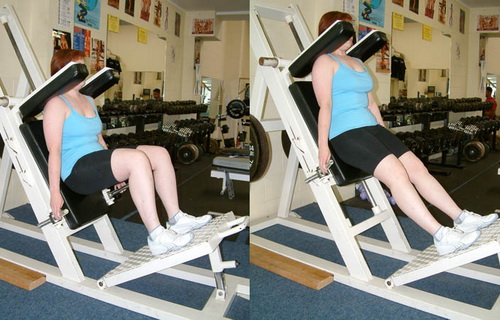
Machine Squats
The squat machine (also called the Smith Machine), is the most ridiculous piece of fitness equipment EVER! It deserves accolades for the sheer lack of thinking that has gone into making it. I've always looked at the squat machine and said to myself, 'there's a machine that's designed, sold, bought and installed by people who've never worked out! Enough with the squabbling and let's have a look at the reasons why I feel so strongly about the squat machine (and you should too!). The squat machine locks the bar in a fixed plane; that's not how your body works when you squat. So the next time you happen to be at the gym, keep an eye on someone who is squatting using that machine and compare it with someone who is using the squat rack. Watch these guys (without making it too obvious, of course!) from the side. The first difference you will notice is that with the guy using a barbell, the bar path isn't in a ram-rod straight line. It will swing back and forth as it travels up and down. That's a normal and healthy bar path (depending on how good that person's technique is, of course)...
The squat machine (also called the Smith Machine), is the most ridiculous piece of fitness equipment EVER! It deserves accolades for the sheer lack of thinking that has gone into making it. I've always looked at the squat machine and said to myself, 'there's a machine that's designed, sold, bought and installed by people who've never worked out! Enough with the squabbling and let's have a look at the reasons why I feel so strongly about the squat machine (and you should too!). The squat machine locks the bar in a fixed plane; that's not how your body works when you squat. So the next time you happen to be at the gym, keep an eye on someone who is squatting using that machine and compare it with someone who is using the squat rack. Watch these guys (without making it too obvious, of course!) from the side. The first difference you will notice is that with the guy using a barbell, the bar path isn't in a ram-rod straight line. It will swing back and forth as it travels up and down. That's a normal and healthy bar path (depending on how good that person's technique is, of course). Contrast that with the squat machine guy and you'll notice that the bar travels in a straight line (since it locked in the machine). Therefore, to compensate the person will have to use an unnatural technique to push the weight up. The most obvious thing is that the person's knees will be stuck way too much in the front at the bottom and he'd be leaning a back a bit - that isn't how a deep squat looks like at the bottom. In the barbell squat - and, I am guessing you are doing real deep squats - your chest will be in between your knees. That doesn't happen with the squat machine. In addition to the 'feel' not quite being there, the wrong biomechanics means squat machines are more likely to cause damage to your knees. This is so because of unnatural joint angles and planes through which you'd be working to push the weight up. Another downside, you won't be working your muscles to the absolute maximum level possible - as you would with a barbell squat. Mind you, there are some squat machines out there that will allow forward and backward movement of the bar as you squat. Yet, no squat machine will ever feel as natural as the barbell squat. Additionally, the act of balancing the bar on your shoulder - rather than letting the machine do that work - is likely to make your stabilizing muscles stronger. Don't get me wrong, over the year I have tried a few things on the squat machine. Jump lunges - or as some tend to call it, the Lunge Sprint (1) - and Deficit Deadlifts (2) are some. However, the machine doesn't ever come up trumps! So, I did the next best thing, gave up and chucked the idea of using the machine out of the window. Sometimes people come up with this excuse for using the squat machine, 'I wanted a little variation in my squat routine'. Well, you want a variation - go for front squats, box squats, overhead squats, ATG squats (ass to grass squats!). If you start researching and digging deep, you'd be amazed at the number of different ways you can add variation to your squat routines. And, all of these variation will eventually get you stronger in your barbell squat. The point is, to resort to machine squats just for the sake of 'variation' is a big mistake! TAKE HOME MESSAGE Squat to your heart's content - using the barbells - not the machine! If you are worried about safety, use safety pins that most squat racks provide these days or ask someone to spot you. Squat is king of exercises! Do not lower its status to a pauper by doing it on the Smith machine!
- Important notification about information and brand names used in this slideshow!
- Photo courtesy of GeorgeStepanek by Wikimedia Commons : en.wikipedia.org/wiki/File:HackSquatMachineExercise.JPG
- 1. http://www.bodybuilding.com/exercises/detail/view/name/lunge-sprint
- 2. http://www.bodybuilding.com/exercises/detail/view/name/deficit-deadlift
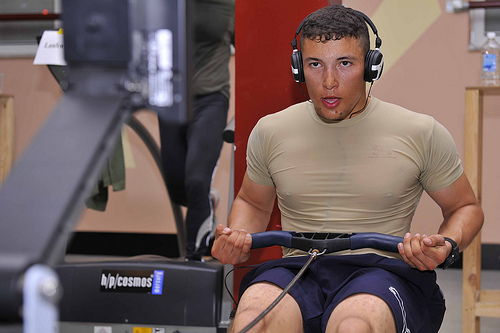
Cardio Machines
Cardio machines are those big things that occupy large spaces in a 'fitness' centre and are supposed to improve your cardiovascular fitness and make you lose weight - no wonder, most women walk into the gym, head straight for the treadmill or the X-trainer, do it for - like - 45 minutes, do some abdominal crunches, head for the shower and off they go! But the fact is, these fancy 'fitness machines' - have to hand it to the makers; they really look good - do very little for you as far as real fitness is concerned. Like, Alanis Morissette so famously said, ISN'T IT IRONIC?! There's an exception though - the ROWER! No wonder the CrossFit community is so obsessed with rowing workouts! Here's my take on cardio machines that are most readily available in almost all gyms. 1. TREADMILL Pros: the treadmill is a great piece of exercise equipment if (a). You are a runner (long or middle distance), and (b). It is pouring or snowing outdoors, and/or (c). you have a genuine reason stopping your from heading outdoors The training advantages of a treadmill end there, PERIOD! It does have important applications in the medicine field though! ...
Cardio machines are those big things that occupy large spaces in a 'fitness' centre and are supposed to improve your cardiovascular fitness and make you lose weight - no wonder, most women walk into the gym, head straight for the treadmill or the X-trainer, do it for - like - 45 minutes, do some abdominal crunches, head for the shower and off they go! But the fact is, these fancy 'fitness machines' - have to hand it to the makers; they really look good - do very little for you as far as real fitness is concerned. Like, Alanis Morissette so famously said, ISN'T IT IRONIC?! There's an exception though - the ROWER! No wonder the CrossFit community is so obsessed with rowing workouts! Here's my take on cardio machines that are most readily available in almost all gyms. 1. TREADMILL Pros: the treadmill is a great piece of exercise equipment if (a). You are a runner (long or middle distance), and (b). It is pouring or snowing outdoors, and/or (c). you have a genuine reason stopping your from heading outdoors The training advantages of a treadmill end there, PERIOD! It does have important applications in the medicine field though! For those looking to lose weight, there are better options available. For runners, you are better off stacking up miles outdoors than indoors - if you are runner worth his/her salt, you would know that treadmill running doesn't imitate outdoor running. Your hamstrings won't get involved on the treadmill as much as it would outdoors. Also, the foot impact on the treadmill will be totally different problem. All of these are likely to increase your chances of knee, ankle or foot injuries. Cons: Here are some reason why you are better off not using the treadmill (a). As stated earlier, the machine pushes your foot back after you plant it. Hamstrings therefore, aren't that involved in pushing your foot back. This can lead to imbalance around the knee joint - strong quads and weak hamstrings - increase risk of knee injuries (b). Repeated impact also increases chances of joint injuries Having said that, the treadmill is still a great tool for those who've been absolutely sedentary and are just beginning out - slow jogs or jog-walk intervals and the likes can still be carried out on the treadmill. But not for long. If you can last 45 on a treadmill, its time you moved on to something more intense. The value of treadmill for testing exercise tolerance and predicting or diagnosing cardiovascular disease has also been proven beyond doubt (1,2,3). 2. X-TRAINER The X-trainer is a better piece of equipment than the treadmill for inducing fat loss (not if you are training for distance running). The reason being that you'd be involving muscles of your upper body as well - especially upper back. More muscle involved, more calories burnt! 3. ROWER (also called the ROWING ERGOMETER) This is the best piece of equipment amongst the three mentioned here. It tends to involve far greater amounts of muscles than either the treadmill or the X-trainer. Also, what I like about the rower is that it is great for getting some 'intervals' under your belt (4). Also, if you are looking to train in the 'anaerobic zone' more often, ROWER is the only way out! I kind of like the 'AS FAR AS YOU CAN GO' workout described by Eric Cressey in the article referenced here. TAKE HOME MESSAGE All cardio machines will great for you if you are just starting out. However, as you improve, you should move on to more efficient machines to get the most of your workout. Generally, the effectiveness (and safety) of cardio machines in inducing weight loss may be comfortably stated as: ROWER > X-TRAINER > TREADMILL
- Important notification about information and brand names used in this slideshow!
- Photo courtesy of isafmedia by Flickr : www.flickr.com/photos/isafmedia/6229046366/
- (1) Wasserman K, Whipp BJ. Exercise Physiology in Health and Disease. The American Review of Respiratory Disease 1975, 112(2):219-249
- (2) Chaudhry S, Arena R, Wasserman K, Hansen JE, Lewis GD, Myers J et al. Exercise-induced myocardial ischemia detected by cardiopulmonary exercise testing. Am J Cardiol 2009, 103(5):615-619
- (3) Wasserman K, Hansen JS, Sue DY. Principles of Exercise Testing and Interpretation. 5th ed. Philadelphia: Lippincott Williams and Wilkins: 2012
- (4) http://www.t-nation.com/free_online_article/most_recent/interval_training_on_the_rowing_ergometer
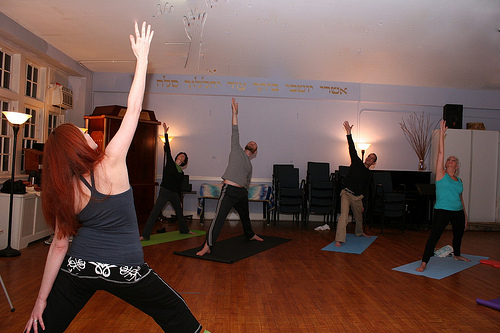
Alternative Exercises
Exercises to relieve stress and increase flexibility like Yoga and Pilates should also be a part of your training. If not too often, I'd suggest throwing in a class once in a blue moon. It does add a bit of variety to your routines. I have always come up feeling fresher after a session of Yoga or Pilates, I'm sure you would too! TAKE HOME MESSAGE: Variety is the name of the game! Throw in a class of Yoga or Pilates once in a while.
- Important notification about information and brand names used in this slideshow!
- Photo courtesy of Jasmine Kaloudis by Flickr : www.flickr.com/photos/synergybyjasmine/6808423095/
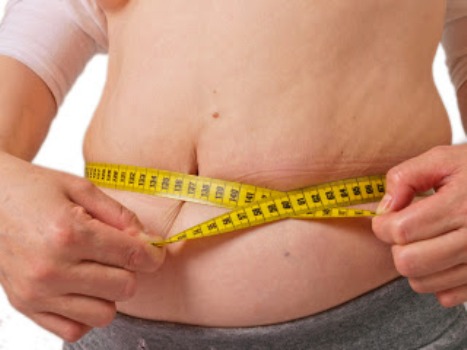
Spot Reduction - Fact Or Fiction?!
Spot reduction, in case you haven't heard about it, is the ability to reduce fat in a specific area of the body - most often than not, in problem areas like the belly or love handles. However, most people including PTs tend to think that spot reduction isn't possible. So, is spot reduction for real or is it just a myth?! Opinion has always been divided regarding the ability of exercises - mainly high rep, moderate to low weight - to cause spot reduction. Most trainers or fitness gurus would laugh in your face, if you asked them or told them about spot reduction causing exercises. Apparently, a strict diet regimen and long-term exercise commitment is the only way out! Although, majority of the 'know-alls' think spot reduction is not possible, my gut feeling is that 'we do not know much about the science behind spot reduction if indeed it is possible'. Hence, I wouldn't take sides on the argument regarding spot reduction. After all, anecdotal evidence - coming from elite athletes (Arnold included) seems to suggest that you can improve muscle sharpness by doing more number of reps (abs for instance). Whether that is possible only when you already...
Spot reduction, in case you haven't heard about it, is the ability to reduce fat in a specific area of the body - most often than not, in problem areas like the belly or love handles. However, most people including PTs tend to think that spot reduction isn't possible. So, is spot reduction for real or is it just a myth?! Opinion has always been divided regarding the ability of exercises - mainly high rep, moderate to low weight - to cause spot reduction. Most trainers or fitness gurus would laugh in your face, if you asked them or told them about spot reduction causing exercises. Apparently, a strict diet regimen and long-term exercise commitment is the only way out! Although, majority of the 'know-alls' think spot reduction is not possible, my gut feeling is that 'we do not know much about the science behind spot reduction if indeed it is possible'. Hence, I wouldn't take sides on the argument regarding spot reduction. After all, anecdotal evidence - coming from elite athletes (Arnold included) seems to suggest that you can improve muscle sharpness by doing more number of reps (abs for instance). Whether that is possible only when you already have low levels of body fat or the high reps just disperse fats from the exercised area temporarily, we will never know! Dr. Lonnie Lowery, an exercise physiologist, has come up with an impressive hypothesis for spot reduction and has suggested ways in which you can burn fat from stubborn area (1). I suggest you read it and try it - it works for you, well and good. If it doesn't, there isn't any harm done. TAKE HOME MESSAGE For all those unlucky ones who struggle to keep fats off those stubborn areas, there's only one way out! Strict as hell diet, training and patience. Fat from the problem areas will the last one to go
- Important notification about information and brand names used in this slideshow!
- Photo courtesy of weight loss program photos by Picasa : picasaweb.google.com/lh/view?q=exercise+for+fat&uname=109008901828086469253&psc=G&filter=1#5877497943773970306
- (1). http://www.t-nation.com/free_online_article/most_recent/spot_reduction_is_real_heres_how_to_do_it
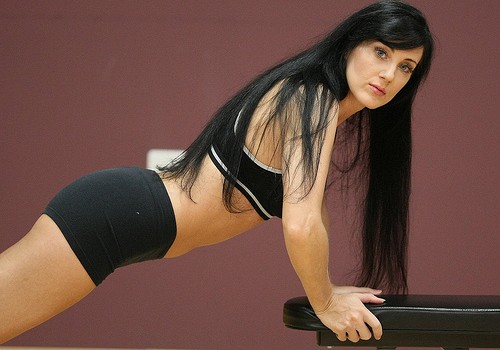
Ways To Get Shaped Up
When they've had enough and they decide to do something about the shape that they are in, most people think of joining a gym. Although resistance training can play a big part in getting you to look the way you want, it is not the only way. And, if you ask me, certainly not the quickest way to get in shape (or even get fitter). Unless of course, you are training to be a bodybuilder, powerlifter or an Olympic lifter. If you are one of those looking to get into 'beach-mode for the summer', here are other ways that can get you there in a canter! Here are some: OUTDOOR TRAINING Ever wondered why athletes look amazing? The main reason is that their training is more functional - tuned towards improving performance. Getting quick over the ground is what is going to make you leaner way sooner than just gym workouts. Some exercises that I would highly recommend are: sprint intervals (1) and outdoor sports like a game of soccer tennis (maybe over the weekend). PLYOMETRICS Plyometrics (also called plyos) are explosive, fast movements - for instance, clap press-ups or jump squats. Plyos, by definition, will have, what I like...
When they've had enough and they decide to do something about the shape that they are in, most people think of joining a gym. Although resistance training can play a big part in getting you to look the way you want, it is not the only way. And, if you ask me, certainly not the quickest way to get in shape (or even get fitter). Unless of course, you are training to be a bodybuilder, powerlifter or an Olympic lifter. If you are one of those looking to get into 'beach-mode for the summer', here are other ways that can get you there in a canter! Here are some: OUTDOOR TRAINING Ever wondered why athletes look amazing? The main reason is that their training is more functional - tuned towards improving performance. Getting quick over the ground is what is going to make you leaner way sooner than just gym workouts. Some exercises that I would highly recommend are: sprint intervals (1) and outdoor sports like a game of soccer tennis (maybe over the weekend). PLYOMETRICS Plyometrics (also called plyos) are explosive, fast movements - for instance, clap press-ups or jump squats. Plyos, by definition, will have, what I like to call it, the 'JUMP COMPONENT'. Plyos work on and improve your muscle stretch reflexes and fast twitch muscle fibers. Result - you are going to get quicker and stronger. Also, since the fast twitch muscle fibers do not posses much potential to grow in size (hypertrophy), you will be getting lean and strong without looking big. So, if you are one of those guys after that lean, model-look or a lady training to get into bikini shape and hate packing on size on your arms or calves, you should indulge more in explosive movements (rather than the traditional bodybuilding type 'slow rep movements'. No matter what people tell you - those exercises are going to pack on a little bit of size!). Box jumps, bench sprints or jump lunges are some examples of plyometric moves. OLYMPIC LIFTING Olympic lifting, at the end of the day, are nothing but plyometric moves. However, before jumping on to Olympic lifting (or the CrossFit bandwagon), I would recommend you have reached a certain level of Squatting proficiency - a barest minimum of handling 1.5X your bodyweight in squats and you are ready to move on to Oly lifts! LEARN NEW SKILLS Do not be satisfied with your training progress, EVER! Always keep pushing the bar up; that is the only way to progress! You always come across people at the gym who keep doing the same stuff over and over again for months and years. The thing is, that ways, your body get used to whatever you are doing and then it stops responding. So, at best you will be maintaining whatever shape or strength levels you are at. However, to keep progressing, you have to keep pushing the bar up all the time. Learning new skills is a great way to do that - handstand press ups, snatches, flips or whatever. What I like about new skill development is that it gives you immense pleasure when you can do something that you have dreaded doing up until yesterday. TAKE HOME MESSAGE Having a one-dimensional approach (muscle size) to your training is the thing that stops most people from achieving their dream bodies. Training to get fitter rather than having bigger muscles (or toning your muscles, as PTs tell most women client) is more likely to give quicker results. One cue that will really work for you or anyone that wants to lose fat and get lean and ripped is 'GET QUICK OVER THE GROUND'. If you follow that simple rule and train towards it, chances are, you may get there in a gallop even, forget a canter!
- Important notification about information and brand names used in this slideshow!
- Photo courtesy of Keith Allison by Flickr : www.flickr.com/photos/keithallison/3805634822
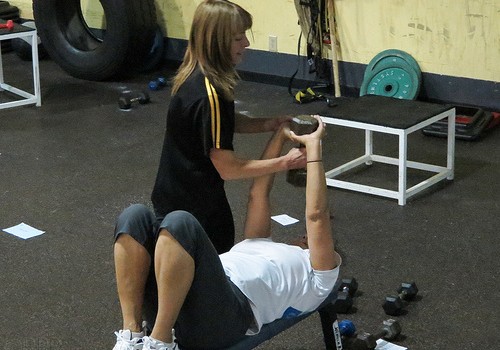
Tips for Injury Free Exercise
Athletes and coaches know the immense importance of avoiding injury. There's a reason for that - Injuries set you back a few months or even years. And, you've got to start from scratch all over again. Also, injuries and niggles - especially those that occur in the playing field or the gym over a period of time (overuse injuries) - are especially notorious to heal. Also, such nagging injuries will - in addition to causing discomfort - will hamper your training progress! The smart thing to do, therefore, is to avoid injuries in the first place! So, how do you avoid getting injured?! The answer is simple really - IMPROVE YOUR TECHNIQUE. Improving technique is the best way to avoid injuries; especially when you start getting stronger and fitter and really start pushing yourself. Here are few things that you can do to improve your technique: 1. READ: Research - with the advent of the internet, there is no dearth of knowledge. Follow some reputed coaches and their tips. 2. PRACTICE: Put that research into practice - work with a coach or a trainer; visualizing yourself in action is quite difficult. 3. VISUALISE: Pictures and videos are also a great...
Athletes and coaches know the immense importance of avoiding injury. There's a reason for that - Injuries set you back a few months or even years. And, you've got to start from scratch all over again. Also, injuries and niggles - especially those that occur in the playing field or the gym over a period of time (overuse injuries) - are especially notorious to heal. Also, such nagging injuries will - in addition to causing discomfort - will hamper your training progress! The smart thing to do, therefore, is to avoid injuries in the first place! So, how do you avoid getting injured?! The answer is simple really - IMPROVE YOUR TECHNIQUE. Improving technique is the best way to avoid injuries; especially when you start getting stronger and fitter and really start pushing yourself. Here are few things that you can do to improve your technique: 1. READ: Research - with the advent of the internet, there is no dearth of knowledge. Follow some reputed coaches and their tips. 2. PRACTICE: Put that research into practice - work with a coach or a trainer; visualizing yourself in action is quite difficult. 3. VISUALISE: Pictures and videos are also a great way to not only study your technique but also to chart your progress to see if you are getting leaner and stronger. TAKE HOME MESSAGE: Improve your exercise technique
- Important notification about information and brand names used in this slideshow!
- Photo courtesy of ROBERT ROCHE by Flickr : www.flickr.com/photos/bobroche/8219180802/


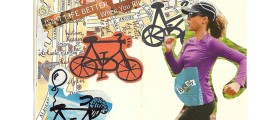
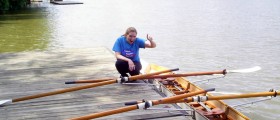
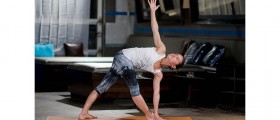
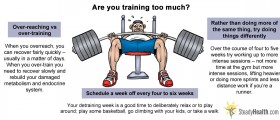
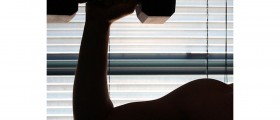

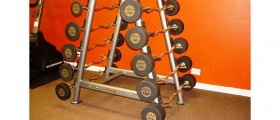

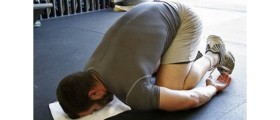
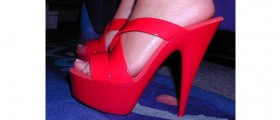
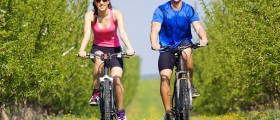

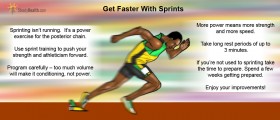
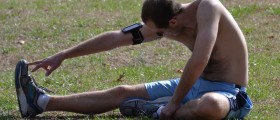


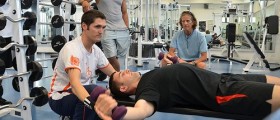
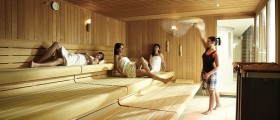

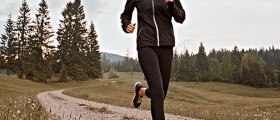
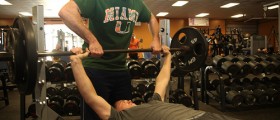
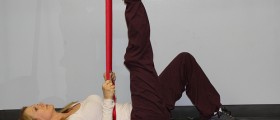

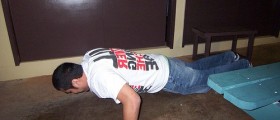
Your thoughts on this
Loading...